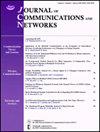融合传感与通信的鲁棒到达方向估计与信号分离方法
IF 3.2
3区 计算机科学
Q2 COMPUTER SCIENCE, INFORMATION SYSTEMS
引用次数: 0
摘要
在这项研究中,我们设计了一种基于分组方案的单通道到达方向(DOA)估计和信号分离算法,用于集成传感和通信系统的时变元表面(tvm)。该方案利用TVM的谐波效应,通过正交傅立叶系数矩阵将接收到的单通道信号转换成多通道信号。在完成多通道DOA估计后,设计相应的加权波束指向进行信号分离。通过在TVM上施加周期调制函数对入射信号进行调制,将信号映射到多维接收空间,从而恢复多通道接收信号。因此,传统的多通道算法可以用于单通道信号的DOA估计。其次,我们设计了一个亚表面加权波束指向,以最大限度地提高接收信号的信噪比。仿真结果表明,所提出的DOA估计方案具有与传统多通道天线阵列相当的性能。此外,基于该方法设计的信号分离方案具有鲁棒性,在低信噪比下仍能保持良好的信号分离能力。本文章由计算机程序翻译,如有差异,请以英文原文为准。
Robust direction-of-arrival estimation and signal separation method for integrated sensing and communication
In this study, we designed a single-channel direction-of-arrival (DOA) estimation and signal separation algorithm based on a grouping scheme for the time-varying metasurfaces (TVMs) for integrated sensing and communication systems. In this scheme, the harmonic effect of the TVM was used to transform the received single-channel signal into a multichannel signal through an orthogonal Fourier coefficient matrix. After achieving multi-channel DOA estimation, the corresponding weighted beam pointing was designed for signal separation. By applying a periodic modulation function on the TVM to modulate the incident signal, the signal was mapped to a multi-dimensional received space to recover the multi-channel received signal. Thus, conventional multi-channel algorithms could be used on the single-channel signal for DOA estimation. Next, we designed a sub-surface weighted beam pointing to maximize the received signal signal-to-interference-plus-noise ratio. Simulation results revealed that the proposed scheme of DOA estimation can exhibit performances comparable to that of the conventional multichannel antenna array. Moreover, the signal separation scheme designed based on this method was robust and could maintain good signal separation ability under a low signal-to-noise ratio.
求助全文
通过发布文献求助,成功后即可免费获取论文全文。
去求助
来源期刊
CiteScore
6.60
自引率
5.60%
发文量
66
审稿时长
14.4 months
期刊介绍:
The JOURNAL OF COMMUNICATIONS AND NETWORKS is published six times per year, and is committed to publishing high-quality papers that advance the state-of-the-art and practical applications of communications and information networks. Theoretical research contributions presenting new techniques, concepts, or analyses, applied contributions reporting on experiences and experiments, and tutorial expositions of permanent reference value are welcome. The subjects covered by this journal include all topics in communication theory and techniques, communication systems, and information networks. COMMUNICATION THEORY AND SYSTEMS WIRELESS COMMUNICATIONS NETWORKS AND SERVICES.

 求助内容:
求助内容: 应助结果提醒方式:
应助结果提醒方式:


